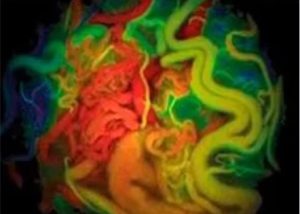In a retrospective cohort study, Yang et al. from The First Affiliated Hospital of Soochow University (Suzhou, Jiangsu) and Beijing Tiantan Hospital, Capital Medical University (Beijing, China), published in World Neurosurgery, evaluated the safety and effectiveness of combining intraoperative indocyanine green video angiography (ICG-VA) with FLOW800 and multimodal fusion neuronavigation in the microsurgical resection of brain arteriovenous malformations (AVMs).
The combined use of ICG-VA, FLOW800, and multimodal neuro-navigation was associated with:
Reduced intraoperative blood loss
Improved functional outcomes
Lower rates of postoperative complications and reoperation
→ Enhancing both the safety and efficacy of AVM microsurgery.
A flashy mix of fluorescence imaging, hemodynamic mapping, and navigation overlays is presented as a major leap forward in AVM surgery. Ninety patients, split into two groups. Outcomes like hemoglobin drop and mRS are tracked. Sounds solid. Until you actually read it.
⚠️ Fatal Methodological Flaws Retrospective Bias Parade: No randomization. No matching. No controls for AVM grade, eloquence, or preoperative hemorrhage. The groups may as well be different species.
Selection Bias in Disguise: Surgeons probably chose to use the “combined approach” in cases where they already expected better outcomes. That’s not innovation — it’s cherry-picking.
The Repetition Problem: Results are stated twice, almost copy-pasted, a red flag for editorial padding and weak analysis.
Outcomes Without Depth: Hemoglobin drop is statistically significant? Great. But was the surgical time longer? Were AVMs larger in one group? Were there intraoperative conversions? You’ll never know — because they didn’t ask.
💡 Technological Fanfare ≠ Scientific Rigor FLOW800 is useful — but not new. ICG-VA has been around for two decades. Multimodal navigation is standard in many centers. What this paper calls a “combined approach” is what high-volume centers consider routine. Wrapping these tools together doesn’t create a paradigm shift. It creates a PowerPoint slide.
💬 What It Should Have Been A prospective, stratified study with AVM grading, eloquence mapping, and independent radiological adjudication. Instead, we got a glorified before-and-after comparison with soft endpoints and flashy tools.
🧠 Final Verdict This article is a sales pitch disguised as science — useful to tech vendors, not to evidence-based neurosurgeons. It recycles known tools and rebrands them as revolution — with no real control, no blinding, and no humility.
Publishable? Maybe. Transformative? Not even close.
